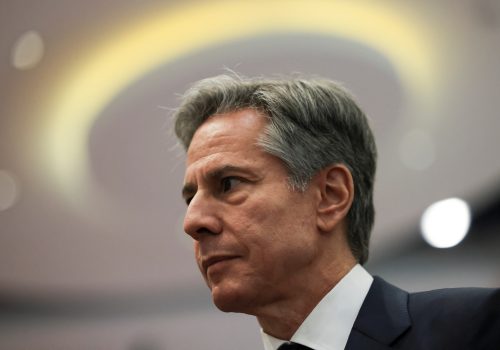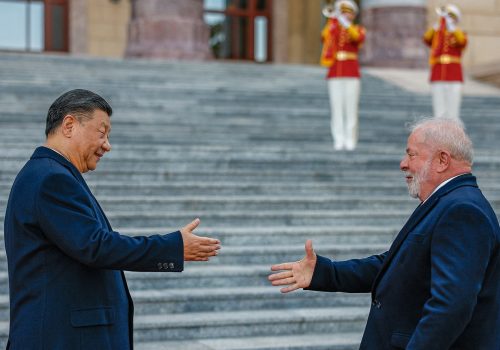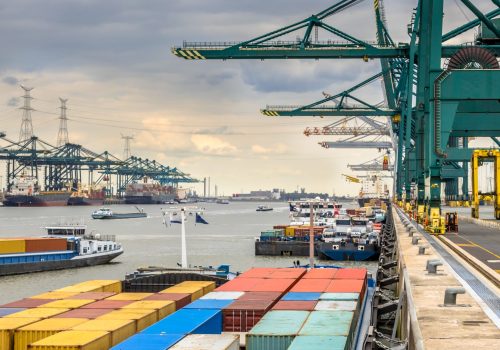An eight-year diplomatic lull is over. So what did EU and Latin American and Caribbean leaders achieve?
Breaking an eight-year dry spell in meeting, more than fifty world leaders and top ministers from Europe and Latin America descended on Brussels in force this week. The purpose: to advance new European Union (EU) outreach toward Latin America and the Caribbean (LAC). That was certainly achieved. But also on display was the contrast between how Europe seeks to interact with the region in comparison with the United States.
The EU-Community of Latin American and Caribbean States (CELAC) Summit was a top priority of the Spanish government, which holds the rotating EU Council presidency. Spain met its objectives with representation from the EU’s twenty-seven member states and the thirty-three CELAC members. But it wasn’t just any representation. LAC countries sent twenty-three presidents and prime ministers to Brussels—the same number of heads of state and government who attended last year’s US-hosted Summit of the Americas, with one big difference: While Cuba, Nicaragua, and Venezuela joined their cohorts in Belgium, none received an invitation to Los Angeles.
The tone of the summit was set at the EU-LAC Business Round Table that took place immediately preceding the leaders’ meeting. Speaking to an overflow audience, European Commission President Ursula von der Leyen opened the gathering in the Berlaymont Building, the Commission’s headquarters, with an emphatic message: “Latin America and the Caribbean and Europe need each other more than ever before.” She then went on to reinforce that “Europe aspires to be a partner of choice for Latin America and the Caribbean,” while announcing more than forty-five billion euros of “high-quality European investment” that will “come with a focus on building local value chains.” Her announcement sparked a round of applause in the room among attendees, who likewise saw the importance of diversifying and deepening Europe’s partnerships.
On the CELAC side, upon taking the stage, Brazilian President Luiz Inácio Lula da Silva highlighted key areas of mutual interest with the EU, including combating climate change and deforestation, while staying clear of comments regarding Ukraine—on which he has differed from his European counterparts. Lula’s remarks were warmly greeted as well but without the same level of excitement as von der Leyen’s financial announcement.
The takeaways: Europe—reeling from Russia’s full-scale invasion of Ukraine and its effects, along with growing apprehension over increased Chinese assertiveness—realizes that it needs to double down on its global partnerships. Here, CELAC represents thirty-two votes at the United Nations (UN). (Venezuela is unable to vote due to being in arrears in the payment of its UN dues.) CELAC is also a fountain of critical raw materials, which Europe is increasingly focused on securing to fuel its green transition. And although China was not mentioned, the summit’s focus on quality and local investments is certainly a swipe at Chinese financing and a doubling down on the EU’s strategy of diversifying its supply chains.
For LAC countries, no convincing was needed to get regional dignitaries to show up. Europe is willing to put forward substantial strategic planning and the funding behind it as it aspires to be “a partner of choice” for LAC. Launched alongside the summit, the new EU-LAC Global Gateway Investment Agenda commits the funding announced by von der Leyen for more than 130 projects through 2027. These projects revolve around four pillars of mutual interest: a fair green transition, an inclusive digital transformation, human development, and health resilience and vaccines. These pillars also stand in stark contrast to the top-down Chinese investments in many parts of the region that have less of an eye toward long-term development objectives.
A distinctly European approach to diplomacy
The summit also reflected the EU’s differing approach to LAC compared with the United States. Start with the invites to Brussels for Cuba, Venezuela, and Nicaragua, with Cuba’s leader, Miguel Díaz-Canel, in attendance. This reflects a softer approach on Europe’s part toward the leaders of countries where the United States has imposed sanctions over abuses of power and human-rights concerns. But it also shows that Europe has less diplomatic leverage in the region than that enjoyed by Washington. The United States was able to cajole countries into attending last year’s Summit of the Americas despite many leaders’ opposition to the snub of Cuba and Venezuela, in particular. CELAC leaders would have been less willing to do so in Brussels. This makes sense. The United States—despite concerns about the growing presence of extra-regional actors in LAC, many of which, unlike Europe, carry nefarious intentions toward US interests—remains the most important strategic partner for the hemisphere.
As well, the Global Gateway—in many respects Europe’s counterproposal to China’s Belt and Road Initiative—shows that Europe recognizes its need to match diplomatic outreach with concrete deliverables and large-scale financing. The billions that are slated to come from Europe far surpass US investment announcements at last year’s Summit of the Americas. So while Europe leaned in on specific projects, the United States used its hemispheric gathering to focus on partnership strategies to jointly tackle issues ranging from inclusive economic development to climate.
Perhaps the biggest feat for the EU was the joint agreement on a declaration coming out of this week’s meeting. With such a diversity of interests and priorities among CELAC members and within the EU, a final joint declaration did not always seem possible. The EU’s proposed language condemning Russia’s invasion of Ukraine was a non-starter for many CELAC diplomats who tend to view the war as primarily a European problem and are concerned about getting dragged into taking a side. Meanwhile, some EU member diplomats have said they have red lines against removing the language condemning Russia’s invasion. CELAC diplomats also wanted a reference in principle that the EU should give reparations for slavery to its member states. The declaration that emerged was the product of skillful negotiation balancing EU and LAC priorities—and competing positions within each region.
Point fifteen of the declaration was the biggest achievement of the summit:
We express deep concern on the ongoing war against Ukraine, which continues to cause immense human suffering and is exacerbating existing fragilities in the global economy, constraining growth, increasing inflation, disrupting supply chains, heightening energy and food insecurity, and elevating financial stability risks. In this sense, we support the need for a just and sustainable peace. We reiterate equally our support for the Black Sea Grain Initiative and the efforts of the [UN secretary general] to secure its extension.
Although Nicaragua abstained from signing on to the declaration because of this Ukraine war language, the rest of the attendees—including Cuba and Venezuela—agreed to it. This language is a major accomplishment for Europe, while CELAC walks away with a substantial investment pledge from the Global Gateway that others could not match.
Looking ahead to 2025
Europe has clearly unleashed a newfound commitment to the Americas. This summit was a strategic balancing act to shore up European partnerships with a region that is becoming vital to global interests and solutions to world problems. However, the EU’s pledging of billions of euros is one thing; delivering the funds and leveraging them into a new economic partnership will require serious follow-up and sustained engagement. Meanwhile, CELAC countries are increasingly able to take advantage of changing global dynamics to advance regional interests.
What would be the best course for the future? The United States and Europe should each have a seat at the table at their respective summits with LAC countries. The EU has now agreed to host a summit with CELAC every two years—the next one will be in 2025, with Colombia offering to host. The Dominican Republic will host the next Summit of the Americas that same year. Doesn’t some degree of alignment make sense heading to 2025? As in many other priority global issues, transatlantic collaboration will ultimately help to win the day.
Jason Marczak is senior director of the Atlantic Council’s Adrienne Arsht Latin America Center. He participated in the EU-CELAC Business Round Table in Brussels preceding the leaders’ meeting. He is on Twitter at @jmarczak.
Jörn Fleck is senior director of the Atlantic Council’s Europe Center.
Further reading
Fri, Jun 30, 2023
Success is not just showing up. Blinken’s Caribbean trip needs to deliver.
New Atlanticist By Wazim Mowla
The US secretary of state heads to Trinidad and Tobago and Guyana, building on recent Biden administration outreach to the region. But if he arrives with little to announce, frustration is likely to brew.
Fri, Apr 14, 2023
What the Lula-Xi partnership means for the world
New Atlanticist By
Brazilian President Luiz Inácio Lula da Silva and Chinese leader Xi Jinping just met in Beijing, but it is who else came on the visit that reveals big changes ahead for the two countries and the world.
Mon, Jun 5, 2023
Enhancing market size, scalability, and regional integration in Latin America and the Caribbean
Report By
To sustain the ongoing recovery against short-term headwinds and boost inclusive, productive, and sustainable development in the long term, governments cannot, and should not, act alone. The private sector can strengthen the hard and soft infrastructure supporting Latin America and the Caribbean’s economies, while drawing them closer together through trade, regulatory, and other integration.


